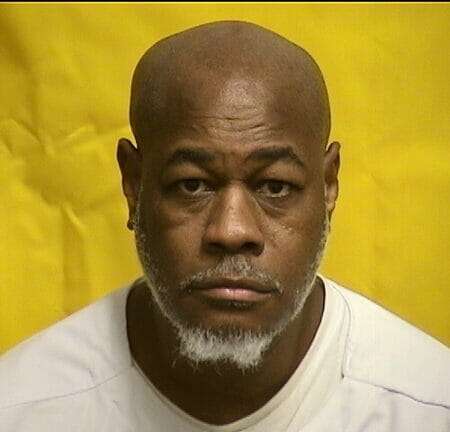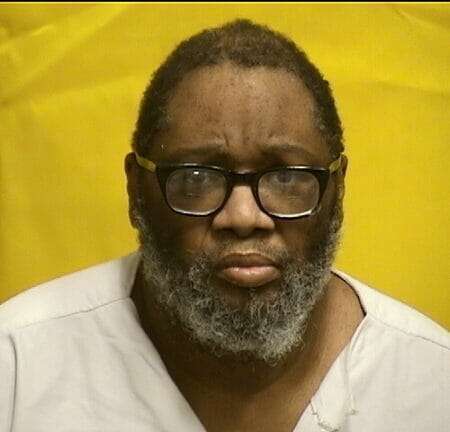
Lamont Hunter was sentenced to death by the State of Ohio for the sexual assault and murder of a three year old boy. According to court documents Lamont Hunter would sexually assault a three year old boy with a sharp object before shaking Trustin Blue causing his death. Lamont Hunter was arrested, convicted and sentenced to death
Lamont Hunter 2021 Information
Number A559336
DOB 08/30/1968
Gender Male Race Black
Admission Date 10/02/2007
Institution Chillicothe Correctional Institution
Status INCARCERATED
Lamont Hunter More News
In late 2003, Hunter and Luzmilda Blue began a romantic relationship. Hunter then started living with Luzmilda and her three boys, Tyree, Tyrell, and Trustin Blue, born September 12, 2002. Hunter was not the biological father of any of these children. Hunter and Luzmilda later became the parents of a girl, Trinity Hunter.
{¶ 4} After Trustin was born, Luzmilda became sick, and Wilma Forte, a family friend, began taking care of Trustin. Trustin had lived with Forte and her daughter, Amber White, five or six days a week until his death.
{¶ 5} On January 30, 2004, Trustin was taken to the emergency room at Cincinnati Children’s Hospital because he was unable to bear weight on his left leg. X-rays showed that Trustin had a broken leg. Hunter told medical personnel that he had fallen on some steps while holding Trustin and had landed on him. Doctors accepted Hunter’s explanation that Trustin’s injuries were accidental.
{¶ 6} On June 9, 2004, Luzmilda took Trustin to the emergency room after noticing that his lips and penis were swollen. She also noticed other injuries on Trustin’s face and head. Trustin had been left in Hunter’s care that day. Luzmilda had not noticed any of these injuries when she left the house earlier that morning.
{¶ 7} Dr. Kathy Makoroff, the examining physician, determined that Trustin had a swollen upper and lower lip, an abrasion in one ear and a scratch on his ear canal, hair loss and bruising on one side of his head, and bruising on the tops of both ears. His penis was swollen and had an abrasion at its base.
{¶ 8} Dr. Makoroff could not rule out the possibility that a bug had gotten into a loose-fitting diaper and had caused the swelling. But a bug bite would not have caused the bruising on the penis. Moreover, X-rays showed that Trustin had suffered several fractures, in addition to the fracture from January. These included an old and a new fracture on a hand and two fractures on a foot. Dr. Makoroff referred Trustin’s case to children services and law-enforcement authorities.
{¶ 9} Tiffany Bradbury, an investigator with Hamilton County Job and Family Services, interviewed Hunter about Trustin’s injuries. Hunter stated that that he did not see any injuries on Trustin on June 9 and denied hurting him. Hunter said that when he was walking down the stairs with Trustin, he had tripped, and maybe Trustin had been injured.
{¶ 10} Criminal charges were not brought against Hunter for Trustin’s injuries. But Trustin was removed from his home in June 2004 and was placed with his aunt, Latoya Gresham. Amber White obtained custody of Trustin six months later. In June 2005, Trustin was returned to Luzmilda’s custody. But after a week, Luzmilda took Trustin back to White’s home.
{¶ 11} Beginning in 2003, White had noticed that Trustin was afraid of Hunter. She stated that Trustin would start crying, shaking, and vomiting when Hunter came around. Forte noticed similar behavior. Forte testified that on one occasion, she was holding Trustin, and he started vomiting when Hunter passed them. On January 17, 2006, two days before he was killed, Trustin told Forte that he was “scared of Lamont. Lamont scared. Lamont hurt Trustin.”
{¶ 12} On January 17, 2006, Trustin was staying at White’s home. That afternoon, Luzmilda picked up Trustin and took him to her home. Before leaving, Forte gave Trustin a bath and dressed him. Forte did not notice any injuries in Trustin’s anal area or elsewhere on his body.
{¶ 13} At 9:00 a.m. on January 19, 2006, Forte spoke to Hunter and Trustin on the telephone for more than 15 minutes. Hunter said that Trustin was fine and was watching a movie. Trustin told Forte that he was watching the movie Jurassic Park. Forte stated that Trustin’s voice sounded shaky, and he did not seem to be his normal, energetic self.
{¶ 14} Two hours later, Hunter called Luzmilda at work and told her that Trustin had been injured. Luzmilda rushed home. At 11:21 a.m., Luzmilda called 9-1-1 and reported that her son had been hurt after falling down the stairs.
{¶ 15} EMTs arriving at the scene found that Trustin had a low pulse rate and labored breathing and was paralyzed and nonresponsive. Lieutenant Eric Prather, a Cincinnati fireman, asked Hunter how Trustin had been injured. Hunter said that Trustin had fallen down the basement steps. Hunter stated that he thought that Trustin had fallen when Trustin had tried to stop Tiffany from going down the steps.
{¶ 16} Dr. Makoroff examined Trustin when he was taken to Children’s Hospital. Hunter and Luzmilda told Dr. Makoroff that Trustin had been in his normal state of health that morning. Hunter then explained that he was in the basement doing laundry with his nine-month-old daughter. He heard some rumbling upstairs and saw Trustin tumbling down the basement steps, landing on the concrete floor. Hunter said that Trustin had been unresponsive when he went to help him. Hunter splashed water on Trustin’s face. When Trustin did not respond, Hunter called Luzmilda at work.
{¶ 17} Dr. Makoroff’s examination of Trustin showed that his injuries were not consistent with a fall down the stairs. Trustin suffered a diffuse injury to his brain. He had subdural hemorrhages on both sides of the brain that extended into the middle of the brain. Swelling of his brain was so severe that it had started to herniate into the spinal column. Further examination showed that Trustin had suffered a deep anal tear. The injury was acute and could have been just hours old. Dr. Makoroff testified that the bruising and lacerations were consistent with the insertion of an object into the anal cavity.
{¶ 18} During the afternoon of January 19, 2006, Cincinnati police detectives Jane Noel and Jim Wiggington interviewed Hunter about Trustin’s injuries. After waiving his Miranda rights, Hunter provided a videotaped statement, most of which was played for the panel at trial. In the video, Hunter addresses questions about Trustin’s 2004 injuries, as well as the ones that he had suffered that day.
{¶ 19} Hunter told police that Luzmilda had left for work at 6:00 that morning. Trustin, Terrell, and Tyree woke up at 8:00 a.m. Terrell and Tyree, ages 8 and 11, left for school at 8:45 a.m. Hunter said that Trustin had been acting fine when he awoke. Trustin ate some breakfast and started watching Jurassic Park.
{¶ 20} Hunter left Trustin in the living room, and he went with Trinity to the basement to do laundry. Shortly thereafter, Hunter heard Trustin running upstairs. Hunter thought that Trustin was excited about the dinosaurs in the movie and was rushing to tell him about them. Hunter then heard Trustin tumbling down the basement stairs. Hunter said that he heard every step that Trustin hit as he fell down the stairs. Hunter turned around and saw Trustin at the bottom of the steps. Trustin was folded over, and his leg was on the bottom step.
{¶ 21} Hunter said that Trustin was limp and unresponsive. He took Trustin upstairs and splashed water on his face. He also attempted to revive Trustin. Hunter then called Luzmilda and told her what happened. She immediately came home and called 9-1-1.
{¶ 22} As the interview progressed, Detective Wiggington told Hunter that the attending physician did not think that Trustin’s injuries were consistent with a fall down the steps. Hunter replied that he did not have “an answer to that.” Hunter stated that what happened was simply an accident. Hunter said that the only thing he could have done differently was to remain upstairs or shut the basement door when he did the laundry.
{¶ 23} Hunter told investigators that nothing else happened to Trustin before the fall. He stated that Trustin had been fine the previous evening and that Trustin had slept with his mother. Hunter said that he would never hurt a child. He also stated that he did not injure Trustin by shaking him. However, investigators did not ask Hunter about the anal tear during the interview, and nothing was mentioned about it.
{¶ 24} On January 20, 2006, Barbara Mirlenbrink, a criminalist with the Cincinnati police department, went to Trustin’s home to collect evidence. She found no evidence of blood or anything of evidentiary value on the basement stairs or elsewhere in the house. Mirlenbrink stated that there were 11 carpeted steps leading from the kitchen to the basement floor. The distance from the top of the stairs to the bottom of the steps was 11 feet, two inches. She also examined the washer and dryer in the basement. She found that the washer was empty, and clothing was on top of the dryer.
{¶ 25} On January 27, 2006, Mirlenbrink returned to Trustin’s home and looked for sharp objects that might have been inserted into Trustin’s anus. Mirlenbrink collected two Tiki torches and a tire gauge. Subsequent forensic testing of these items disclosed nothing of evidentiary value. But Mirlenbrink stated that blood was found on the underwear that Trustin had been wearing.
{¶ 26} On January 21, 2006, CT scans showed that Trustin was brain dead. On January 22, 2006, Dr. Mona Stephens, the Hamilton County deputy coroner, conducted the autopsy on Trustin. Her examination found two separate areas of broad impact on Trustin’s head. The brain itself was very swollen and had a subarachnoid hemorrhage. Trustin also suffered a serious neck injury. Dr. Stephen stated that the cartilage had been pulled loose from the thoracic vertebra.
{¶ 27} Dr. Stephens stated that the two distinct impact sites show that something had struck Trustin in the head or his body had been slammed against something. She stated, “[I]f he were struck in the head, it would have to be a blow such that the neck would then travel in a sharp fashion and * * * [would require] a major amount of force.” Alternatively, Dr. Stephens said that “if he were picked up and held by the torso or below and hit against something, that would be an easier injury to produce * * * because there is more movement associated with that to pop that disk loose from the spine bone.”
{¶ 28} Dr. Stephens found a 1.9 centimeter laceration of Trustin’s anus. There was a hemorrhage along the rectum’s lining and a hemorrhage going into both sides of the pelvis. There were also three areas of perforation of the rectal mucosa. Dr. Stephens stated that these perforations “would be similar to what you could produce with something like a pencil, jammed with a pencil or something sharp like that, or could even be from an angled insertion of something.”
{¶ 29} Dr. Stephens concluded, “[D]iffuse brain injury due to blunt impact/shaking injuries to the head [is] the cause of death. The manner of death is homicide.” She stated that Trustin’s injuries were not consistent with a fall down the steps. Dr. Stephens also testified, “The only way I can conceive of this being partially caused by a fall down 11 carpeted steps is if he had fallen off the side of the stairs and landed on his head twice, and that still wouldn’t have explained the anal injuries.”








